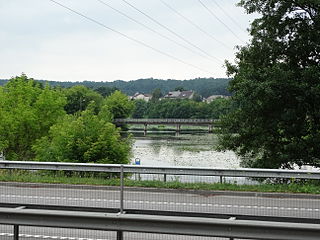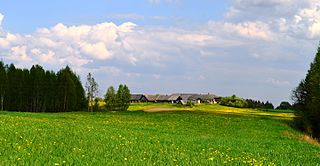
Vilnius is the capital and largest city located in Lithuania. As of January 2024, Vilnius' estimated population was 602,430, while the Vilnius urban area extends beyond the city limits and had an estimated population of 708,627.

Kaunas is the second-largest city in Lithuania after Vilnius, the fourth largest city in the Baltic States and an important centre of Lithuanian economic, academic, and cultural life. Kaunas was the largest city and the centre of a county in the Duchy of Trakai of the Grand Duchy of Lithuania and Trakai Palatinate since 1413. In the Russian Empire, it was the capital of the Kaunas Governorate from 1843 to 1915.

Vilnius County is the largest of the 10 counties of Lithuania, located in the east of the country around the city Vilnius and is also known as Capital Region or Sostinės regionas by the Lithuanian statistics department and Eurostat. On 1 July 2010, the county administration was abolished, and since that date, Vilnius County remains as the territorial and statistical unit.

Vilnius District Municipality is one of the 60 municipalities in Lithuania. It surrounds the capital city of Vilnius on three sides. The municipality is also bordered by Trakai district and Elektrėnai municipality in the west, Astravyets and Ashmyany districts of Belarus in the east, Širvintos, Molėtai and Švenčionys districts in the north and Šalčininkai district in the south.

Trakai District Municipality is one of 60 municipalities in Lithuania.
Russians in Lithuania number 140,000 people, according to the Lithuanian estimates of 2015, or 4.8% of the total population of Lithuania.

Grigiškės is a city in the Vilnius city municipality, Lithuania. It is an industrial town with AB Grigiškės, a major paper factory built in 1923. Grigiškės is situated on both banks of the Vokė river, south from the river Neris.

Darius and Girėnas stadium is a multi-use stadium in Kaunas, Lithuania. With a seating capacity of 15,315, it is the largest stadium in Lithuania and the Baltic states. Located in the Ąžuolynas park in Žaliakalnis district, it serves as a venue for football matches, athletic competitions, and other events. In 1998, the stadium was renovated according to UEFA regulations, and in 2005, it was modernised with the installation of the biggest stadium television screen in the Baltic states. The latest renovation started in 2018 and ended in 2022. During the sporting season, at least 50 events are held here annually.

Didžioji Riešė is a village and administrative centre of Riešė eldership, Vilnius District Municipality, Lithuania. It is located only about 1 kilometre (0.62 mi) north-west of Vilnius city municipality, on the road Vilnius–Molėtai. At the 2011 census, the village had a population of 2,520. That was an increase from the 2001 census which recorded the population of 1,142.
2019 Lithuanian Football Cup, SHARP LFF Cup was the 31st independent Lithuania and the 74th overall national football cup tournament.
Vytautas Landsbergis-Žemkalnis was a Lithuanian architect most active in interwar Lithuania (1926–1939). He was the father of Vytautas Landsbergis, the first Lithuanian head of state after independence from the Soviet Union.
Lithuanian design comprises interior, fashion, industrial and graphic design. The appearance of design usually being related to the industrial revolution. In Lithuania, the state restitution in 1918, National Revival and the rapid growth of Kaunas city were the most important factors. Lithuanian design was influenced by Bauhaus, Lithuanian national patterns and ethnographic elements. Most prominent examples of Lithuanian design are chairs by Jonas Prapuolenis, interiors of buildings in Kaunas in the interbellum period, vacuum cleaner Saturnas.
Antanas Rimvydas Čaplinskas was a Lithuanian energy engineer, historian and prominent author of books about history of Vilnius. He was a Member of the First Council of the Vilnius city Sąjūdis, later from 1990 to 1995 he worked in the Vilnius City Council. In 2008, Čaplinskas was awarded the Statuette of Saint Christopher for his scientific works about Vilnius.

The Army of Central Lithuania was the armed forces of the state of Central Lithuania proclaimed by General Lucjan Żeligowski on October 12, 1920.

Riešė Eldership is an eldership in Lithuania, located in Vilnius District Municipality, north of Vilnius.

The Central Lithuanian Offensive on Kaunas was a military offensive of the Republic of Central Lithuania, led by General Lucjan Żeligowski, on the territories of Lithuania, that took place between October and 30 November 1920.

Vilniaus Street is a central and the oldest street in the Kaunas Old Town.

The Kaunas urban area is the metropolitan area of Kaunas. The metropolitan area covers two municipalities in the Kaunas County, with a total area of 250 km2.


























